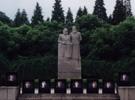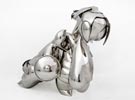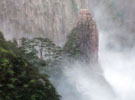For What: “Doing” Arts
By Jiang Yuehong
In reviewing Contemporary Art in China, if we have been used to appropriately eyeing it, we can hardly position an artist’s piece unless we find certain evidences of social reality and causes in art history to interpret his practice. Well, with such an apparently straight and cold look and referential identification, we will forwardly neglect and screen the artist’s own personal experiences of life and his motif of an art delivery. As a result, our questions on those practices of Contemporary Art in China may probably be bounded to what an artist does and how he does it and as for why he does it, saying, why and for what an artist does an art, it becomes a necessity in name only and is referred to no more.
What does “art” really mean then? To certain artists, it will be a concept requiring a serious consideration time after time. However, to Li Hongjun who prefers addressing himself an “artisan” rather than an “artist”, his own “doing” an art over twenty years long has been an answer in action to the question. On the other hand, consciously or unconsciously of self-knowledge or not, his “doing” an art has been corresponding to the key pulse of the peak of the contemporary art tide in China – from his piece of traditional Spring Festival art selected into the Sixth National Art Exhibition, to his graduate pieces risen up as one share of the New Trend of “After ’89” Realism in Oil Painting Art, to his installations recognized as a personal case of experimental art in the early 90s during the interim from a folk world to the modern world as well as from traditional art to specific-site art.
His piece “Prosperous Spring & Fruitful Fall” with an effect of a woodcut on purpose was selected into the Sixth National Art Exhibition, 1984. In it, the woman is after his pregnant wife at that time, sitting against a door where there pasted is a pair of couplet with its horizontal theme “Prosperous Spring & Fruitful Fall” corresponding to the title. All these reveal his observing and expressing about life in a poetic, simple and natural tone. At the time, the practice of Contemporary Art in China was silently transiting from social wounded traces to farming life in subject and the concept of painting the countryside realistically was formally suggested.
The oil painting series “Wife, Baby, Rooster”, his graduate pieces completed in a class of 3-year-long study in the department of Folk Art, Central Academy of Fine Arts, is an extension that the artist himself has tried quite long to achieve after his previous series “Wife, Baby, Rooster”, and since then, he stops his practice in painting. An absence of self can be traced behind his concerns about his personal daily life delivered by these paintings. With certain slight sense of self-mockery, his anxieties about his own daily life released from his pieces put his art practices as magnum opuses of the New Trend of “After ’89” Realism in Oil Painting Art, which features most clear and vigorous arisen in Chinese art circle, along with those of Fang Lijun, Liu Xiaodong and so on. Although such a new atmosphere created by its practices is named “Humorous Realism” by Li Xianting, “Realism of Existence” by Gao Minglu, and “Cultural Realism” by Zhang Xiaojun, there seems only a reality but no “-ism”-related ideology. For example, there appears a “Portrait of Chairman Mao” in the piece, which is quoted by others as a symbol of “Political Bop” , but, said by himself, it is just pasted there with no special intention. His reality in life and in art is reflected via the series. Taking the advantages of his professional refinement and mastery of Chinese folk fine arts, he endues the painting menus with an air of super-realism. Regarding the rooster playing its best skill s to break loose from the woman’s desire as a man’s symbol , the Out of the door where the rooster are flying, baby crying while the wife busy, there are a pair of hurry legs, which may be regarded as a vivid self-reflection that the artist himself is immediately fleeing from the spot.
During 1992 to 1993, the installation series “Red Spider” presents a visualization of “netting” displaying his realization of the life conditions in reality, which is also an actual development of expressional form in terms of an effective delivery of an idea. Series I is a visualized presentation focusing on the nets as containers in function. Either penetrating or obstructing into and out of the nets, escaping or entering, or, covering or exposing, very closely associated with each other, each serves as a condition to another. It seems that forward or backward is just up to a sudden idea. “Red Spider II” is a development in expression and program. The piece goes beyond the application of “netting” just as a symbol in taking “netting” for an expression. That the netting is applied to make up the shortage or imperfection of our daily life is a kind of highlighted display of the shortage or imperfection. In transforming between truth and fakeness, such a fruitless make-up just leaves us certain sense in form only, and then what is exactly the value of labor to us? At that time, regarded as a manner of “having a foot in two camp”, the two “Transiting” Exhibits planned by Prof. Lv Shengzhong demonstrates how Chinese art was transiting from the form of folk art to that of modern art in expression. As to Li himself, he took predicting experiments from painting to installations with no hesitation, which also reserved certain highly expected room for him to express in his coming practice of the series “Dao·Utensils” ,1995 – the ordinary objects adopted to make theirs shapes into books, where physical material and metaphysical spirit are displayed by visualization, being a concept of contradiction in a compromise of each other for a new born rather than absolutely opposite to each other.
If we say that Li’s sensitive mastery and very personal deliveries of painting themes and installation expressions enable what he has done to be a valuable personal case due to the logics of modern art practice in China, his constant attention and addiction to the material “Paper” since the series “Dao· Utensils” to the present are just described by his own statement: “Perhaps my predestinated life is just like those empty caves continuously through or between those paper layers.” As to Li who claims “his family has been farmers for generations all the time” , paper bears all the pages of his life changes. A drawing paper pasted on a wall was favored by a CPC secretariat of the village and an officer of local education who were both arranged having a meal with his family, then, Li, a high school graduate, left from the Valley Gun-liu-gou to the village and changed his job from being an accountant of the Li-family Village downstream to be a contracted employee in the town cinema. Afterwards, a diploma in art issued to him by Shangxi Fengxiang Normal School, a technical secondary school, made him, the first graduate from such a school in his village, becoming a local cadre in the cultural office of the Qian-yang county and earning the state-paid salary. An oil painting of Spring Festival theme selected into a national art exhibition let his name recorded in the county annals. An official document from National Administration of Culture to select and train certain cadres from grass roots let him get a chance via his success in exam of studying in a class of 3-year-long program in Central Academy of Fine Arts, which also let him step into the developing path of contemporary art practice in China. after 10 years of his life at an arm’s length to contemporary art, it is a diploma of master in art issued by Central Academy of Fine Arts that makes him back to Beijing for the third time with his official rank as Dean of Shangxi Provincial Art Hall left behind. Then, the head and hand constructed by him with the thousand white papers respectively taken from a book of no character let him start cooperating with art galleries as a freelance artist in identity. Such a practice also re-started his predestinated relation with Contemporary Art in China.
Certainly, to everyone, paper is a proof. Paper is referred in economy as well as in ideology. It is paper that has witnessed and structured our daily life, carried and built up all what we image about material and spirit. However, Li’s “into papers” leads us encountering the alienation of paper and experiencing the ambiguity and significance of paper: physically and metaphysically as well, trustable and distrustful as well, light and heavy as well, thin and thick as well, none and ens as well – from the series 《Dao·Utensils》(1995), those daily utensils identified from the literal books bearing Dao; taking cut papers as currency in Money Tower and using Chinese paper money for the death to exchange for the foreign/worldly money; now, he cuts his own 3-dimensional figure into thousands of white paper pieces and then re-set up various appearances of “I” – it is not because he know the designation of paper very well but because he is in certain distance from it that such an alienation is effectively presented and expressed. In fact, it is because paper is a symbol of culture and of economy as well rather than because paper as a material is so handy in daily life but that Li recognize the distance and force as well as the pressure and helplessness caused by education and money. Such pressure and helplessness borne in paper is hidden to most of people, however, Li succeeds in telling it out vividly via his piece, achieving his effective delivery of visualizing it repeatedly.
As a matter of fact, not only the subject of “Wife, Baby, Rooster” but also the symbolization of “Netting” and the devotion of “Into Papers” all deliver Li’s interrogation and chewing of his personal experiences in life. His motif in art is always suspending and wrapped up around his specific arts. His co-existing identities such as farmer, cadre and artist are of his reality as well of his own choice. For what to do an art is not only his infatuation but also his instinct – which releases his respect to the labor in art and his fantasy of trying to get away from the material or bodiless bound. Perhaps, it is this sense of predestination toward art that lets Li’s “doing” arts become a very special example for us to prize in our establishment of a system of contemporay art practice in China.
( translated by Jiang Wenhui)
水天中,《关于乡土写实绘画的思考》,《美术》,1984年10月号。
小尘(按:即刘骁纯),《强聚焦的现实》,《江苏画刊》,1992年1月号。
1996年,李红军实施这一行为是在德国慕尼黑名家剧院,“聚焦中国现代艺术展” 的开幕式上,以纸钱按艺术家自定的汇率和观众换外币,即用冥币换人世的阳钱。在这里作为外币的“洋钱”和人世使用的“阳钱”谐音,也让艺术行为与其实施空间的特定关系成为作品解读的要素。
Shui Tianzhong, “Thinking on Realistic Countryside Paintings”, Fines Arts, Oct. 1984
Xiachen (Remarks: Liu Raochun’s pseudonym): “A Reality Extremely Focused on”, Jiang Su Pictorial, 1992.1.
In 1996,Le implemented this behavior on the opening ceremony of the Art Exhibition “Focus on Chinese Modern Art in the Master theatre, Munich, Germany. He used Chinese paper money for funeral ceremony to exchange for various foreign currencies with the audiences at the rates settled by himself, which means using paper money supposedly used by the death to exchange for the money used in the world. Here the Chinese word “洋” for foreign is pronounced as “yang” , same as another Chinese word “阳”which has a meaning of “worldly” in English. Such a partial tone associated to the currencies involved in his art behavior makes the given relation between his art action and the place for it an important attribute to the interpretation of his piece.




